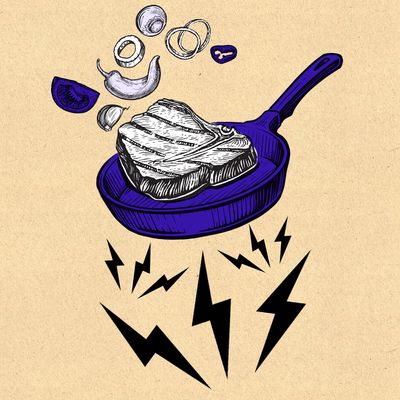
Photo-Illustration: The Strategist; Photos Getty Images
Induction cooking has been around for decades, but in the last few years it’s gained popularity among chefs and home cooks alike as an alternative to the gas stoves that have reigned supreme for decades. You can chalk its popularity up to a combination of factors: government mandates to electrify newly constructed home kitchens and recent scientific studies published about emissions from gas stoves posing health risks. Induction burners, which are powered by electricity but function differently than a classic coil-style electric stove, can heat faster and more efficiently than other kinds of stoves, making them an appealing option.
As soon as it’s turned on, an induction burner sets up an electromagnetic field between the burner and the pan it’s in contact with, creating eddy currents, or swirling electrical currents, in the metal of the pan (as long as that pan is magnetic), and the resistance of the metal to those currents in turn creates heat throughout the pan and all at once. (Gas and conventional electric burners apply heat to the surface of the pan, which then requires more time to spread to the rest of the pan.)
According to Ari Matusiak, founder and CEO of Rewiring America, the largest pro-electrification nonprofit in the United States, a gas stove transfers only about 40 percent of its heat energy to a piece of cookware. A traditional electric coil stove transfers about 74 percent, while induction stoves transfer closer to 90 percent of their electrical energy. The result is that cookware heats as much as three times faster than electric or gas.
Induction also offers more precision, with the ability to heat cookware to a specific temperature or make adjustments with a much faster response time. That precision is something Thomas McNaughton, co-chef of Flour + Water Hospitality Group, appreciates: “Like when we’re making ricotta, we know that the milk absolutely will not boil over because we’re able to set it to cook to an exact temperature.” McNaughton and his co-chef Ryan Pollnow like induction cooking so much that they’re in the process of moving toward all-induction cooktops in their forthcoming pizza shops.
Air quality is both an environmental and safety advantage when it comes to induction, especially as compared to gas stoves. Matusiak cited several recent studies that have shown that indoor cooking with gas has comparable health effects to secondhand smoke and increases chances of childhood asthma. Gas cooking releases a chemical called benzene which is linked to leukemia and other types of cancers. Improving indoor air quality is a major motivation in the legislation aimed at moving toward induction.
There are additional safety advantages. Induction cooktops only work when there’s a pot or pan on the unit; and even with a pan on it, the glass or ceramic top doesn’t get as hot as a gas or electric-coil burner. They’re also hard to turn on accidentally, and you don’t have to worry about any open flames.
These concerns, both environmental and for their staff, have informed McNaughton and Pollnow’s move toward induction. They’re in the process of pursuing B Corp Certification, which takes into consideration their environmental footprint. Using induction allows them to significantly reduce their restaurant’s energy usage.
Induction also stands apart in terms of cleanup. Their flat glass or ceramic surface makes them easy to wipe down, and even when something boils over or spills, it won’t scorch on the cooktop because the surface doesn’t get hot enough to burn it.
You may have heard that not all pans work with induction, and that’s because for this transfer of energy to occur, the pan must be magnetic. That means that some pans, especially aluminum and some stainless-steel pans, cannot be used on induction. The good news, though, is that cast-iron pans, carbon-steel pans, and enamel cast iron are all ideal for induction. It’s okay to use pans that are larger than the induction burner, but like a large pan set over a smaller electric or gas burner, they’ll only heat up right where they’re in contact with the burner.
For tasks like finishing pasta that require lots of movement of a pan, induction can pose a problem. While gas can offer ambient heat when a pan is lifted off the burner, induction requires full contact for the electromagnetic currents to move heat, meaning that lots of lifting and moving of the pan can interrupt the cooking process. Induction also requires electricity, which means that it will not work during power outages.
The Strategist is designed to surface useful, expert recommendations for things to buy across the vast e-commerce landscape. Every product is independently selected by our team of editors, whom you can read about here. We update links when possible, but note that deals can expire and all prices are subject to change.
https://news.google.com/rss/articles/CBMiQ2h0dHBzOi8vbnltYWcuY29tL3N0cmF0ZWdpc3QvYXJ0aWNsZS93aGF0LWlzLWluZHVjdGlvbi1jb29raW5nLmh0bWzSAQA?oc=5
2024-06-24 13:00:44Z
CBMiQ2h0dHBzOi8vbnltYWcuY29tL3N0cmF0ZWdpc3QvYXJ0aWNsZS93aGF0LWlzLWluZHVjdGlvbi1jb29raW5nLmh0bWzSAQA
Bagikan Berita Ini

















0 Response to "What Is Induction Cooking and How Does It Work? - New York Magazine"
Post a Comment